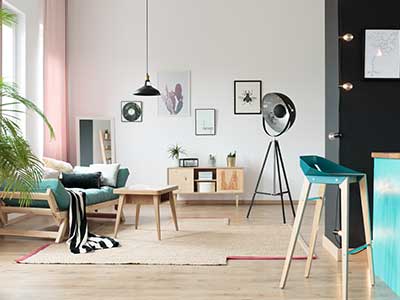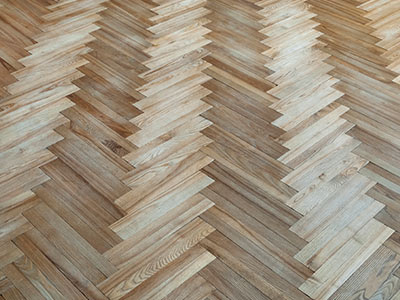Back to Flooring Products
How to Choose the Best Wooden Floor for Your Living Room

A beautiful hardwood floor can transform your living room, offering endless possibilities for creating a space filled with elegance, cosiness, and warmth. Beyond aesthetics, real wood flooring is renowned for its durability, longevity, and ability to create a welcoming and stylish atmosphere.
With an impressive variety of wood species, colours, patterns, textures, and finishes, selecting the right floor can feel overwhelming. Whether you’re aiming for a modern, minimalistic design or a classic, timeless look, you’ll find a wooden floor that perfectly suits your vision.
Ultimately, the choice of wood flooring for your living room comes down to your personal preferences, lifestyle needs, and the overall style you wish to achieve. However, making an informed decision requires understanding how different wood types and finishes impact the space.
In this guide, we’ll share essential tips and recommendations to help you choose the best wooden floor for your living room. For additional insights, you can also explore our dedicated article on why hardwood flooring is ideal for living rooms.
Real wood flooring has the potential to become the statement piece of the interior of every room and dictate the overall style and atmosphere of the room. It is one of the most important, if not the most important, aspects of the interior of every room, and it can stand out with beauty and elegance or blend seamlessly with the rest of the interior to ensure more harmony and tranquillity in the room. Whether you will make a bolder and more distinctive choice or you would choose a more classic and safe option, real wood flooring will certainly add a lot of character to your living room space, along with a lot of charm, beauty, durability, cosiness, functionality, and comfort. Here are the main aspects you would like to consider when choosing a wooden floor for your living room.
Choosing the Right Wood Species for Your Living Room Floor
Selecting the right wood species is a crucial step when choosing wood flooring for your living room. Each species offers unique characteristics in terms of colour, grain patterns, texture, and overall durability. This variety allows you to find the perfect match for your interior style and household needs. Since the living room typically experiences high foot traffic and daily use, it’s essential to prioritise hardwood species known for their strength and resilience.
Best Wood Species for Living Rooms
- Oak: Highly durable, versatile, and available in a variety of shades. A classic choice for its toughness and timeless appeal.
- Walnut: Known for its rich, dark tones and strong resistance to impact and wear.
- Ash: A hard and resilient species with a lighter tone, ideal for modern interiors seeking durability and brightness.
Other Suitable Options
- Maple: A medium-hard wood with a smooth, clean grain, suitable for moderate traffic areas.
- Cherry: Offers a warm, reddish tone and decent durability, though softer than oak or walnut.
- Birch: A budget-friendly option with attractive grain patterns, best for homes with lighter usage.
It's advisable to avoid softer wood species in high-traffic areas like living rooms, as they are more prone to scratches, dents, and surface wear.
For more information on wood floor durability and species selection, visit our comprehensive guide on wood floor finishes and species.
Solid Wood, Engineered, or Parquet: Which Type of Wood Flooring is Best for Your Living Room?
When selecting wood flooring for your living room, you’ll generally choose between three main types:
Solid Wood Flooring
Solid wood floors are crafted from a single piece of timber, offering unmatched authenticity and timeless appeal. However, they are sensitive to moisture and temperature fluctuations, which can cause expansion, contraction, and potential damage. For this reason, solid wood is not recommended for areas with high humidity.
Engineered Wood Flooring
Engineered floors feature a top hardwood veneer layer over a core of crisscrossed plywood or HDF layers. This structure significantly improves moisture resistance and dimensional stability. Engineered wood is a practical alternative to solid wood, especially in environments with variable humidity, though in living rooms, where moisture levels are generally stable, both types can be suitable.
Parquet Flooring
If you’re seeking to add classic charm and visual interest to your living room, parquet flooring is an excellent choice. With intricate patterns like herringbone and chevron, parquet creates a distinctive, formal look while still providing the durability of real wood.
For an in-depth comparison of these flooring types, check our article on solid, engineered, and parquet flooring pros and cons.
Wood Flooring Installation Methods for Living Rooms

The installation method of your living room wood flooring plays a crucial role in its performance and longevity. The most common methods include:
- Nailing Down
- Gluing Down
- Floating Installation
The choice of method depends on several factors, including the type of flooring and the type of subfloor in your living room.
Nailing Down & Gluing Down
Solid wood floors and parquet flooring are typically glued down to concrete subfloors or nailed down to wooden or plywood subfloors. These methods provide a stable and secure fit, essential for heavier, more rigid flooring materials.
Floating Installation
Engineered wood flooring offers greater flexibility with its ability to be installed using the floating floor method. This involves connecting floorboards without fixing them to the subfloor, making it ideal for:
- Subfloors that are not perfectly level
- Areas where quick installation is preferred
- Spaces with underfloor heating systems
The floating method also allows for easier replacement and maintenance, which can be an advantage in busy living areas.
Choosing the Right Wood Floor Colour for Your Living Room
When it comes to wood floor colours, the options are virtually limitless. Different wood species offer a natural spectrum of colours — from pale, almost white tones to deep, dark shades approaching black. Beyond their natural beauty, wood floors can also be professionally stained to achieve completely new colours and finishes.
Choosing the right wood flooring colour for your living room depends on your style and the overall interior design of the space. Whether you prefer warm golden tones, rich dark hues, or trendy grey washes, there’s a perfect match for every taste.
General Tips for Choosing Floor Colours
- Lighter wood floors are ideal for smaller living rooms as they can make the space feel larger, brighter, and more open.
- Darker wood floors add depth, sophistication, and can create a dramatic contrast, particularly effective in larger or well-lit rooms.
- Neutral mid-tones offer versatility and blend seamlessly with various furniture and decor styles.

Understanding Wood Floor Grades for Your Living Room
When choosing wood flooring for your living room, it's essential to understand the concept of wood floor grades. Grading refers to the visual appearance of the wood, not its quality or durability. All grades offer the same level of performance — the difference lies in the floor’s aesthetic character.
Main Wood Flooring Grades
- Prime Grade: Characterised by minimal colour variation and few, if any, natural features such as knots, swirls, or sapwood. Ideal for creating a sleek, minimalist, and airy interior design.
- Select Grade: Offers a balanced look with some natural variation and small knots, providing warmth and subtle character without overwhelming the space.
- Natural Grade: Features more visible knots, swirls, and colour variations, giving the floor a more authentic and lively appearance.
- Rustic Grade: The most visually dynamic option, showcasing significant colour variation, larger knots, swirls, and sapwood. Perfect for interiors seeking charm, uniqueness, and a bold statement floor.
Your choice of wood floor grade depends entirely on your personal preferences and the desired atmosphere of your living room. Whether you want a clean, modern look with prime grade boards or a floor full of character with a rustic grade, the right option will enhance your home’s overall aesthetic.
For further insights into wood floor characteristics, you may also find our article on choosing between hardwood and parquet flooring useful.
Choosing the Right Floorboard Size for Your Living Room
Floorboard size plays an important role in the overall look and feel of your living room wood flooring. Floorboards are available in various widths, lengths, and thicknesses, allowing you to tailor the final appearance of your space according to your design preferences.
Wider and Larger Floorboards
- Ideal for smaller rooms — they create the illusion of a larger, more open space.
- Perfect for informal, relaxed interiors, such as farmhouse or rustic styles.
- Provide a clean, minimalistic look with fewer seams and a more expansive feel.
Smaller and Narrower Floorboards
- Best for larger or formal spaces where intricate patterns and detailed flooring designs are desired.
- Create visual interest and make the floor a standout feature in the room.
- Commonly used in parquet flooring for more decorative layouts like herringbone or chevron.
Ultimately, the choice between wider or narrower floorboards depends on your style and how you want your living room flooring to impact the space visually.
Choosing the Right Floorboard Installation Direction for Your Living Room
One often-overlooked design element in wood flooring is the direction of installation. The way you lay your floorboards can significantly influence the visual perception of your living room, providing an opportunity to create a unique and attractive style that complements the rest of your interior.
General Guidelines
- Typically, floorboards are installed parallel to the main source of natural light. This enhances the feeling of spaciousness and helps highlight the floor’s natural beauty.
- In narrow spaces or hallways, boards are often laid lengthwise to make the room appear longer.
Experimenting with Floorboard Direction
- Installing boards diagonally or in a herringbone pattern can add dynamic visual interest and a sense of sophistication.
- Creative installation directions can help define zones in open-plan living areas.
While aesthetics are important, the subfloor structure and room layout may influence or limit your options. For instance, for better structural integrity, your floor installer may recommend a specific direction that ensures optimal performance and stability.
Always consult with an experienced wood floor fitting specialist to discuss the best installation direction for your space.